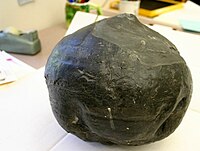
Photo from wikipedia
Based on the measured in situ stress data in China’s coal mines, the relationship among the type of stress field, magnitude of stress, stress value, and the depth of burial… Click to show full abstract
Based on the measured in situ stress data in China’s coal mines, the relationship among the type of stress field, magnitude of stress, stress value, and the depth of burial was analyzed. The trends in the changes in side pressure coefficient and side pressure ratio were regressed and fitted with the increase in depth. This was compared to the Hoek-Brown curve, and the distribution characteristics and variation laws of underground stress field in China’s coal mines were determined. (1) Generally, in situ stress increases with burial depth, but the geological structure and lithology render horizontal stress considerable. (2) In 87.72% of stress fields, which are considered typical tectonic stress fields, the horizontal stress comes into prominence. (3) About 64% working environment is the middle- and high-stress zones, and low- and ultrahigh-stress zones account for about 18% each. (4) The ratio of horizontal principal stress was distributed within a range of 1.0~2.5, and it was affected very little by burial depth. However, the difference increased continuously with burial depth, causing an obviously growing shear failure of coal and rock. (5) The side pressure coefficient is mostly distributed in 0.9~2.0, and it decreases with burial depth and is gradually close to 1.32. (6) Most side pressure ratio is in 0.5~1.6. When the burial depth is less than 700~750 m, the horizontal principal stress is lower than one in the world. Conversely, the magnitude of horizontal principal stress was more pronounced in deeper areas, but it always plays a leading role in the in situ stress field. (7) The seismic belt has a great influence on coalfield stress fields. Without affecting the stress field, the direction of maximum principal stress is approximately parallel or perpendicular to the trajectories of principal stress in China Continental Plate. However, under the composite effect of geological structure, the direction changed visibly. There is no apparent relationship between the two and no law to follow. The statistics of in situ stress are important reference values for understanding stress distribution in China’s coal mines, and it also has a practical guiding significance for safely and efficiently mining underground.
Journal Title: Arabian Journal of Geosciences
Year Published: 2020
Link to full text (if available)
Share on Social Media: Sign Up to like & get
recommendations!